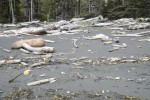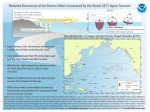One of the  more fascinating subjects that seem to occupy the news is the tsunami debris field that has slowly descended on western parts of Canada. Earlier this year, a Japanese HD motorcycle that washed up in Canada made the headlines after news reporters managed to find the owner of it, who had apparently barely managed to survive the disaster.
more fascinating subjects that seem to occupy the news is the tsunami debris field that has slowly descended on western parts of Canada. Earlier this year, a Japanese HD motorcycle that washed up in Canada made the headlines after news reporters managed to find the owner of it, who had apparently barely managed to survive the disaster.
According to latest estimations, the field contains 1.5 million tons of debris, which has BC authorities pondering what to do with the problem:
“Stuff has been coming across the Pacific forever but to see the start of 3 million tonnes of debris washed off the land and head across the ocean towards us was something I never thought I would see. There’s a wait-and-see approach and most people want to take some action. But it’s a very huge job and we haven’t seen anything yet coming from the government on plans on how to be ready for it and what we’re going to do when the debris hits.”
The US’s NOAA has an extensive site dedicated to the problem (here), which includes an interesting infographic about the field itself and where most of the debris might land (using current and wind models). While the NOAA infographic doesn’t mention any possible findings of human remains, a US oceanographer expects that people might find sneakers with bones in them:
site dedicated to the problem (here), which includes an interesting infographic about the field itself and where most of the debris might land (using current and wind models). While the NOAA infographic doesn’t mention any possible findings of human remains, a US oceanographer expects that people might find sneakers with bones in them:
“We’re expecting 100 sneakers with bones in them,” Curt Ebbesmeyer told a tsunami symposium Monday, “DNA may identify people missing since the March 2011 tsunami. That may be the only remains that a Japanese family is ever going to have of their people that were lost. We’re dealing with things that are of extreme sensitivity. Emotional content is just enormous. So be respectful”
Ebbesmeyer, who is the co-creator of the “Ocean Surface Current Simulator computer model”, expects the amount of debris to peak in October of this year.
